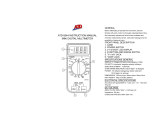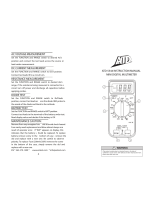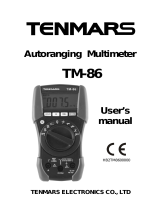[2] APPLICATIONS AND FEATURES
2-1 Applications
This instrument is a portable digital multimeter designed to
measure light electric circuits. The instrument offers not only
measurements for small communication equipments, home
electric appliances, output from a wall socket, and many batteries,
also circuit analyses with additional functions.
2-2 Features
Compliant with IEC61010-1 CAT. 600V, CAT. 1000V, and safe
design using fuses with large number of breaking capacity.
50000-count display (DCV, ACV, DCA, ACA, Ohm)
500000-count display (DCV)
99999-count display (Hz)
Fast response display
(Numeric parts: 5 times/Sec. Bar graph part: 60 times/Sec.
where 50000-count display mode)
Dual Display shows "Voltage or Current and its Frequency", and
"AC components and DC components of Voltage or Current"
True RMS detection for alternate current (AC) (True RMS)
DC+AC indications available
Low-pass filter for Variable Frequency Drive (VFD) circuit
dBm indication for decibel measurement
Resolution: 0.001 mV for DCV, 0.01mV for ACV
Frequency (Sensitivity selectable),
Wide capacitance range (0.01nF to 25.00mF)
Automatically range selectable Crest Capture Mode
Sampling time: Approx. 0.8ms
MAX/MIN/AVG recording mode with auto ranging
(Sampling rate: 20times/Sec. in the voltage or current function)
Relative mode with auto ranging
Back light to allow for easy visibility in low-lit area
Temperature measurement
(K-type thermocouple: –50 to 1000 )
PCLink7 (separately available software) allows you to download
logged data into your PC with USB optical communication unit
(KB-USB7)

























